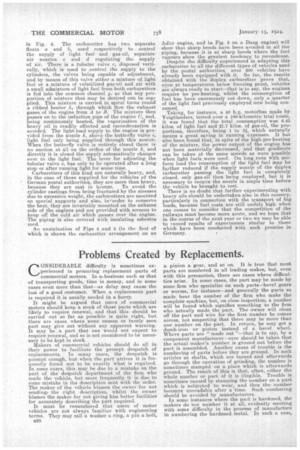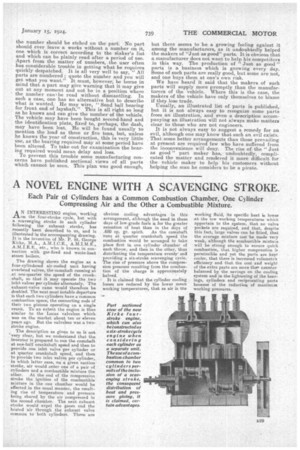Problems Created by Replacements.
Page 12

Page 13

If you've noticed an error in this article please click here to report it so we can fix it.
CONSIDERABLE difficulty is sometimes experienced in procuring replacement parts of commercial motors. In a. business such as that of transporting goods, time is money, and in some cases even more than that—as delay may cause the loss of a good customer. When a replacement part is required it is usually needed in a hurry.
It might be argued that users of commercial motors should keep a stock of those parts which are likely to require renewal, and that this should be carried out so far as possible is quite right, but there are eases where some unseen or iarely seen part may give out without any apparent warning. It may be. a part that one would not expect to require renewal, and so is not considered to be necessary to be kept in stock.
Makers of commercial vehicles should do all in their power to facilitate the prompt despatch of replacements. In many eases, the despateh is prompt enough, but when the part arrives it is frequently found not to be exactly what is required. In sonic cases, this may be due to a mistake on the part of. the despatch department of the firm who made the vehicle, but more frequently it is due to some mistake in the description sent with the order. The maker of the vehicle blames the owner for not sending/ the right description, whilst the owner blames the maker for not giving him better facilities for accurately describing the part required.
It must be remembered that users of motor vehicles are not always familiar with engineering terms. They may call a washer a ring, a pin a bolt, B28
a pinion a gear, and so on. It is true that most parts are numbered in all leading makes, but, even with this precaution, there are cases where difficulties arise. In some cases, the part may be made by some firm who specialize on such parts—bevel gears or worms, for instance—and generally the parts so made bear the number of the firm who make the complete machine, but, on close inspection, a number will be found which signifies something to the firm who actually made the part. The owner will clean off the part and wire for the first number he comes across, not suspecting that there may be more than one number on the part. In return, he may get a dumb-iron or piston instead of a bevel wheel. Where parts are "made out "—that is to say, by a component manufacturer—care should be taken that the actual maker's number is ground out before the part is assembled. Another cause of trouble is the numbering of parts before they are ground. In such articles as shafts, which are turned and afterwards go through the operation of grinding, the number is sometimes stamped on a place which is afterwards ground. The result of this is that, often, either the -whole number or part of it is illegible. Trouble is sometimes caused by stamping the number on a part which is subjected to wear, and then thenumber becomes unreadable after a time. Sueh numbering should be avoided by manufacturers.
In some instances where the part is hardened, the makers do not number it at all, evidently meeting with some difficulty in the process of manufacture in numbering the hardened metal. In such a case,
the number should be etched on the part. No part should ever leave a works without a number on it, one which is correct according to the niaker's list and which can be plainly read after a period of use. Apart from the matter of numbers, the user often has considerable trouble in getting what he requires quickly despatched. It is all very well to say, "All parts are numbered ; quote the number and you will get what you want." It must, however, be borne in mind that a part may give warning that it may give out at any moment and not be in a position where the number can 'be read without dismantling. In such a case, one has no alternative but to describe what is wanted. He may wire, "Send ball bearing for front end of layshaft." This is all right so long as he knows and can give the number of the vehicle. The vehicle may have been bought second-hand and the identification plate, fixed to, perhaps, the dash, mayhave been lost. He will be found usually to mention the load as three or five tons, but, unless he knows the year of construction, this is very little use, as the bearing required may at some period have been altered. To take out for examination the bearing required would mean delay and loss.
To prevent this trouble some manufacturing concerns have published sectional views of all parts which cannot be seen. This plan was good enough, but there seems to be a growing feeling against it among the manufacturers, as it undoubtedly helped the makers of "Just as good" parts. It is obvious that a manufacturer does not want to help his competitors in this way. The production of Just as good" parts is a business which is growing every day. Some of such parts are really good, but some are not, and one buys them at one's own risk. We have heard it said that the makers of such parts will supply more promptly than the manufacturers of the vehicle. Where this is the case, the makers of the vehicle have only themselves to blame if they lose trade. Usually, an illustrated list of parts is published, but it is not always easy to recognize some parts from an illustration, and even a description accompanying an illustration will not always make matters clear to those who are not engineers.
It is not always easy to suggest a remedy for an evil, although one may know that such an evil exists. That some better arrangements than those prevailing at present are required, few who have suffered from the inconvenience will deny. The rise of the "Just as good" part maker has, undoubtedly, complicated the matter and rendered it more difficult for the vehicle maker to help his customers without helping the man he considers to be a pirate.






























